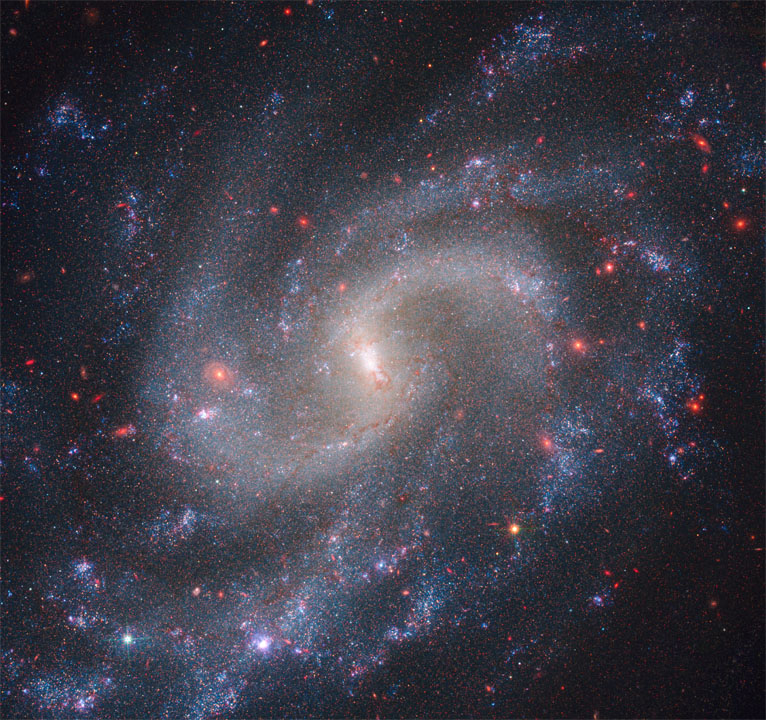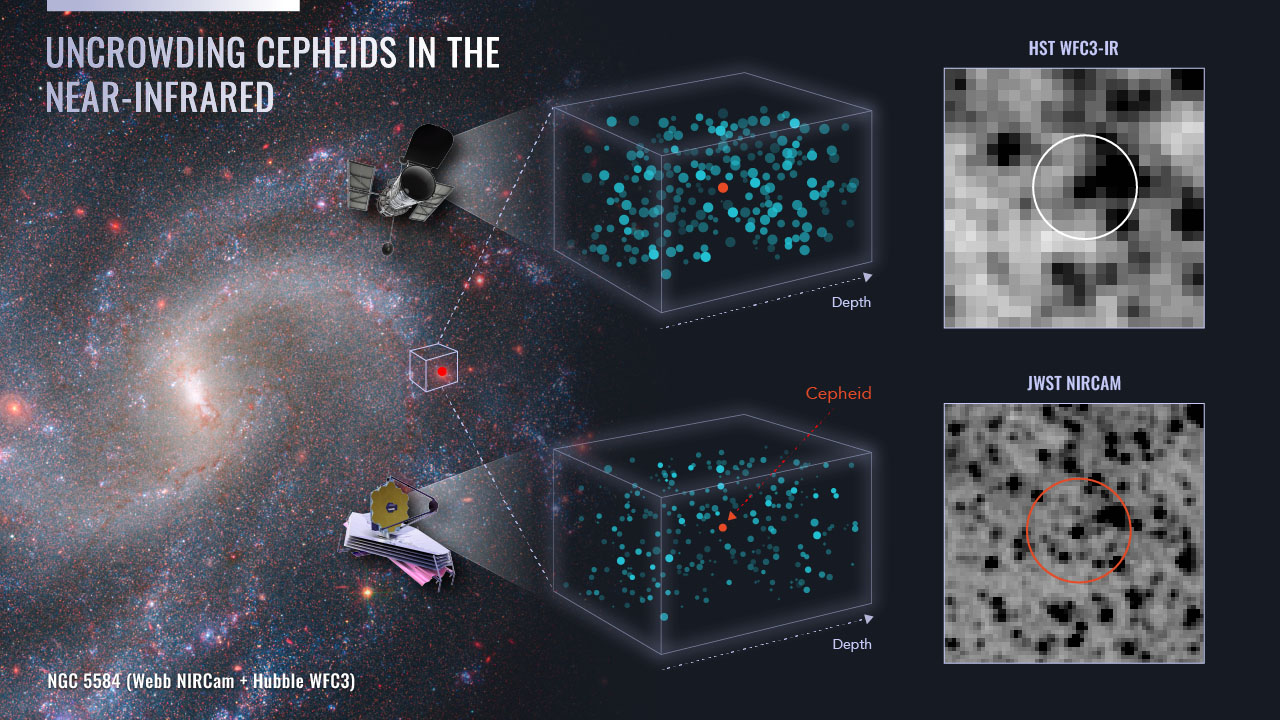| Sep 14, 2023 |
Webb confirms accuracy of universe's expansion rate measured by Hubble, deepens mystery of Hubble constant tension
|
|
(Nanowerk News) The rate at which the universe is expanding, known as the Hubble constant, is one of the fundamental parameters for understanding the evolution and ultimate fate of the cosmos. However, a persistent difference called the “Hubble Tension” is seen between the value of the constant measured with a wide range of independent distance indicators and its value predicted from the big bang afterglow.
|
|
NASA’s James Webb Space Telescope provides new capabilities to scrutinize and refine some of the strongest observational evidence for this tension. Nobel Laureate Adam Riess from the Johns Hopkins University and the Space Telescope Science Institute presents his and his colleagues’ recent work using Webb observations to improve the precision of local measurements of the Hubble constant.
|
 |
| Combined observations from NASA’s NIRCam (Near-Infrared Camera) and Hubble’s WFC3 (Wide Field Camera 3) show spiral galaxy NGC 5584, which resides 72 million light-years away from Earth. Among NGC 5584’s glowing stars are pulsating stars called Cepheid variables and Type Ia supernova, a special class of exploding stars. Astronomers use Cepheid variables and Type Ia supernovae as reliable distance markers to measure the universe’s expansion rate. (Image: NASA, ESA, CSA, and A. Riess, STScI).
|
|
“Did you ever struggle to see a sign that was at the edge of your vision? What does it say? What does it mean? Even with the most powerful telescopes, the ‘signs’ astronomers want to read appear so small that we struggle too.
|
|
“The sign cosmologists want to read is a cosmic speed limit sign that tells us how fast the universe is expanding — a number called the Hubble constant. Our sign is written into the stars in distant galaxies. The brightnesses of certain stars in those galaxies tell us how far away they are and thus for how much time this light has been traveling to reach us, and the redshifts of the galaxies tell us how much the universe expanded over that time, hence telling us the expansion rate.
|
|
“A particular class of stars, Cepheid variables, has given us the most precise measurements of distance for over a century because these stars are extraordinarily bright: They are supergiant stars, a hundred thousand times the luminosity of the Sun. What’s more, they pulsate (that is, expand and contract in size) over a period of weeks that indicates their relative luminosity. The longer the period, the intrinsically brighter they are. They are the gold standard tool for the purpose of measuring the distances of galaxies a hundred million or more light years away, a crucial step to determine the Hubble constant. Unfortunately, stars in galaxies are crowded together in a small space from our distant vantage point and so we often lack the resolution to separate them from their line-of-sight neighbors.
|
|
“A major justification for building the Hubble Space Telescope was to solve this problem. Prior to Hubble’s 1990 launch and its subsequent Cepheid measurements, the expansion rate of the universe was so uncertain astronomers weren’t sure if the universe has been expanding for 10 billion or 20 billion years. That’s because a faster expansion rate will lead to a younger age for the universe, and a slower expansion rate will lead to an older age of the universe. Hubble has better visible-wavelength resolution than any ground-based telescope because it sits above the blurring effects of Earth’s atmosphere. As a result, it can identify individual Cepheid variables in galaxies that are more than a hundred million light-years away and measure the time interval over which they change their brightness.
|
|
“However, we also must observe the Cepheids at the near-infrared part of the spectrum to see the light which passes unscathed through intervening dust. (Dust absorbs and scatters blue optical light, making distant objects look faint and fooling us into believing they are farther away than they are). Unfortunately, Hubble’s red-light vision is not as sharp as its blue, so the Cepheid starlight we see there is blended with other stars in its field of view. We can account for the average amount of blending, statistically, the same way a doctor figures out your weight by subtracting the average weight of clothes from the scale reading, but doing so adds noise to the measurements. Some people’s clothes are heavier than others.
|
 |
| This diagram illustrates the combined power of the NASA’s Hubble and Webb space telescopes in nailing down precise distances to a special class of variable star that is used in calibrating the expansion rate of the universe. These Cepheid variable stars are seen in crowded star fields. Light contamination from surrounding stars may make the measurement of the brightness of a Cepheid less precise. Webb’s sharper infrared vision allows for a Cepheid target to be more clearly isolated from surrounding stars, as seen in the right side of the diagram. The Webb data confirms the accuracy of 30 years of Hubble observations of Cepheids that were critical in establishing the bottom rung of the cosmic distance ladder for measuring the universe’s expansion rate. At the left, NGC 5584 is seen in a composite image from Webb’s NIRCam (Near-Infrared Camera) and Hubble’s Wide Field Camera 3. (Image: NASA, ESA, A. Riess (STScI), W. Yuan (STScI)). (click on image to enlarge)
|
|
“However, sharp infrared vision is one of the James Webb Space Telescope’s superpowers. With its large mirror and sensitive optics, it can readily separate the Cepheid light from neighboring stars with little blending. In the first year of Webb operations with our General Observers program 1685, we collected observations of Cepheids found by Hubble at two steps along what’s known as the cosmic distance ladder. The first step involves observing Cepheids in a galaxy with a known, geometric distance that allows us to calibrate the true luminosity of Cepheids. For our program that galaxy is NGC 4258. The second step is to observe Cepheids in the host galaxies of recent Type Ia supernovae. The combination of the first two steps transfers knowledge of the distance to the supernovae to calibrate their true luminosities. Step three is to observe those supernovae far away where the expansion of the universe is apparent and can be measured by comparing the distances inferred from their brightness and the redshifts of the supernova host galaxies. This sequence of steps is known as the distance ladder.
|
|
“We recently got our first Webb measurements from steps one and two which allows us to complete the distance ladder and compare to the previous measurements with Hubble (see figure) Webb’s measurements have dramatically cut the noise in the Cepheid measurements due to the observatory’s resolution at near-infrared wavelengths. This kind of improvement is the stuff astronomers dream of! We observed more than 320 Cepheids across the first two steps. We confirmed that the earlier Hubble Space Telescope measurements were accurate, albeit noisier. We have also observed four more supernova hosts with Webb and we see a similar result for the whole sample.
|
|
“What the results still do not explain is why the universe appears to be expanding so fast! We can predict the expansion rate of the universe by observing its baby picture, the cosmic microwave background, and then employing our best model of how it grows up over time to tell us how fast the universe should be expanding today. The fact that the present measure of the expansion rate significantly exceeds the prediction is a now decade-long problem called “The Hubble Tension.” The most exciting possibility is that the Tension is a clue about something we are missing in our understanding of the cosmos.
|
|
“It may indicate the presence of exotic dark energy, exotic dark matter, a revision to our understanding of gravity, or the presence of a unique particle or field. The more mundane explanation would be multiple measurement errors conspiring in the same direction (astronomers have ruled out a single error by using independent steps), so that is why it is so important to redo the measurements with greater fidelity. With Webb confirming the measurements from Hubble, the Webb measurements provide the strongest evidence yet that systematic errors in Hubble’s Cepheid photometry do not play a significant role in the present Hubble Tension. As a result, the more interesting possibilities remain on the table and the mystery of the Tension deepens.”
|
|
The James Webb Space Telescope is the world’s largest, most powerful, and most complex space science telescope ever built. Webb will solve mysteries in our solar system, look beyond to distant worlds around other stars, and probe the mysterious structures and origins of our universe and our place in it. Webb is an international program led by NASA with its partners, ESA (European Space Agency) and the Canadian Space Agency.
|
|
This article highlights data from a paper that was accepted by The Astrophysical Journal ("Crowded No More: The Accuracy of the Hubble Constant Tested with High Resolution Observations of Cepheids by JWST").
|


